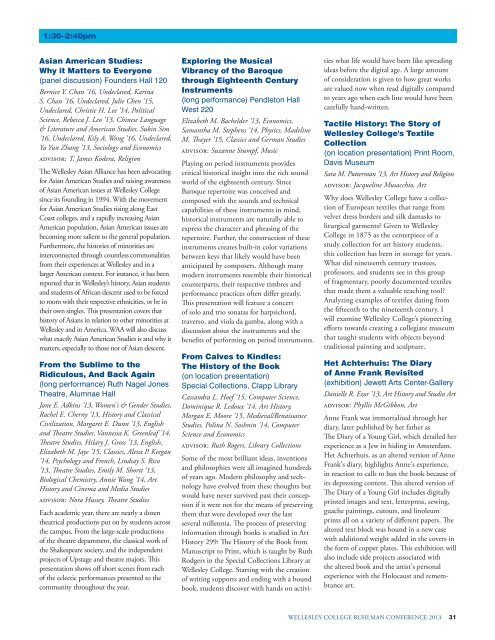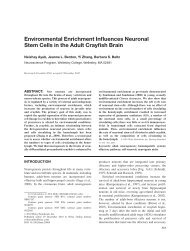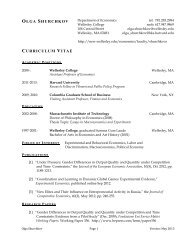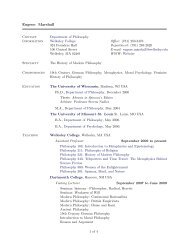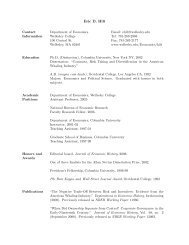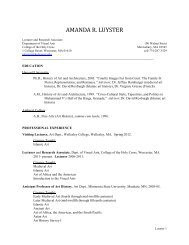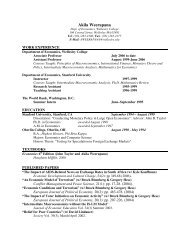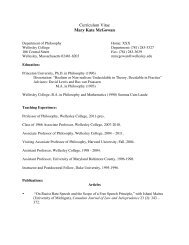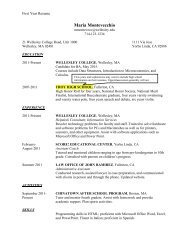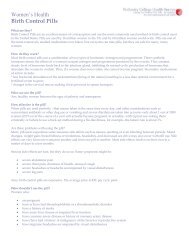Complete Conference Program - Wellesley College
Complete Conference Program - Wellesley College
Complete Conference Program - Wellesley College
You also want an ePaper? Increase the reach of your titles
YUMPU automatically turns print PDFs into web optimized ePapers that Google loves.
1:30–2:40pm<br />
Asian American Studies:<br />
Why it Matters to Everyone<br />
(panel discussion) Founders Hall 120<br />
Bernice Y. Chan ’16, Undeclared, Karina<br />
S. Chan ’16, Undeclared, Julie Chen ’15,<br />
Undeclared, Christie H. Lee ’14, Political<br />
Science, Rebecca J. Leo ’13, Chinese Language<br />
& Literature and American Studies, Sukin Sim<br />
’16, Undeclared, Kily A. Wong ’16, Undeclared,<br />
Ya Yun Zhang ’13, Sociology and Economics<br />
AdvisoR: T. James Kodera, Religion<br />
The <strong>Wellesley</strong> Asian Alliance has been advocating<br />
for Asian American Studies and raising awareness<br />
of Asian American issues at <strong>Wellesley</strong> <strong>College</strong><br />
since its founding in 1994. With the movement<br />
for Asian American Studies rising along East<br />
Coast colleges, and a rapidly increasing Asian<br />
American population, Asian American issues are<br />
becoming more salient to the general population.<br />
Furthermore, the histories of minorities are<br />
interconnected through countless commonalities<br />
from their experiences at <strong>Wellesley</strong> and in a<br />
larger American context. For instance, it has been<br />
reported that in <strong>Wellesley</strong>’s history, Asian students<br />
and students of African descent used to be forced<br />
to room with their respective ethnicities, or be in<br />
their own singles. This presentation covers that<br />
history of Asians in relation to other minorities at<br />
<strong>Wellesley</strong> and in America. WAA will also discuss<br />
what exactly Asian American Studies is and why it<br />
matters, especially to those not of Asian descent.<br />
From the Sublime to the<br />
Ridiculous, And Back Again<br />
(long performance) Ruth Nagel Jones<br />
Theatre, Alumnae Hall<br />
Jane E. Adkins ’13, Women's & Gender Studies,<br />
Rachel E. Cherny ’13, History and Classical<br />
Civilization, Margaret E. Dunn ’13, English<br />
and Theatre Studies, Vannessa K. Greenleaf ’14,<br />
Theatre Studies, Hilary J. Gross ’13, English,<br />
Elizabeth M. Jaye ’15, Classics, Alexa P. Keegan<br />
’14, Psychology and French, Lindsay S. Rico<br />
’13, Theatre Studies, Emily M. Shortt ’13,<br />
Biological Chemistry, Annie Wang ’14, Art<br />
History and Cinema and Media Studies<br />
AdvisoR: Nora Hussey, Theatre Studies<br />
Each academic year, there are nearly a dozen<br />
theatrical productions put on by students across<br />
the campus. From the large-scale productions<br />
of the theatre department, the classical work of<br />
the Shakespeare society, and the independent<br />
projects of Upstage and theatre majors. This<br />
presentation shows off short scenes from each<br />
of the eclectic performances presented to the<br />
community throughout the year.<br />
Exploring the Musical<br />
Vibrancy of the Baroque<br />
through Eighteenth Century<br />
Instruments<br />
(long performance) Pendleton Hall<br />
West 220<br />
Elizabeth M. Bachelder ’13, Economics,<br />
Samantha M. Stephens ’14, Physics, Madeline<br />
M. Thayer ’15, Classics and German Studies<br />
AdvisoR: Suzanne Stumpf, Music<br />
Playing on period instruments provides<br />
critical historical insight into the rich sound<br />
world of the eighteenth century. Since<br />
Baroque repertoire was conceived and<br />
composed with the sounds and technical<br />
capabilities of these instruments in mind,<br />
historical instruments are naturally able to<br />
express the character and phrasing of the<br />
repertoire. Further, the construction of these<br />
instruments creates built-in color variations<br />
between keys that likely would have been<br />
anticipated by composers. Although many<br />
modern instruments resemble their historical<br />
counterparts, their respective timbres and<br />
performance practices often differ greatly.<br />
This presentation will feature a concert<br />
of solo and trio sonatas for harpsichord,<br />
traverso, and viola da gamba, along with a<br />
discussion about the instruments and the<br />
benefits of performing on period instruments.<br />
From Calves to Kindles:<br />
The History of the Book<br />
(on location presentation)<br />
Special Collections, Clapp Library<br />
Cassandra L. Hoef ’15, Computer Science,<br />
Dominique R. Ledoux ’14, Art History,<br />
Morgan E. Moore ’15, Medieval/Renaissance<br />
Studies, Polina N. Soshnin ’14, Computer<br />
Science and Economics<br />
AdvisoR: Ruth Rogers, Library Collections<br />
Some of the most brilliant ideas, inventions<br />
and philosophies were all imagined hundreds<br />
of years ago. Modern philosophy and technology<br />
have evolved from these thoughts but<br />
would have never survived past their conception<br />
if it were not for the means of preserving<br />
them that were developed over the last<br />
several millennia. The process of preserving<br />
information through books is studied in Art<br />
History 299: The History of the Book from<br />
Manuscript to Print, which is taught by Ruth<br />
Rodgers in the Special Collections Library at<br />
<strong>Wellesley</strong> <strong>College</strong>. Starting with the creation<br />
of writing supports and ending with a bound<br />
book, students discover with hands on activi-<br />
ties what life would have been like spreading<br />
ideas before the digital age. A large amount<br />
of consideration is given to how great works<br />
are valued now when read digitally compared<br />
to years ago when each line would have been<br />
carefully hand-written.<br />
Tactile History: The Story of<br />
<strong>Wellesley</strong> <strong>College</strong>'s Textile<br />
Collection<br />
(on location presentation) Print Room,<br />
Davis Museum<br />
Sara M. Putterman ’13, Art History and Religion<br />
AdvisoR: Jacqueline Musacchio, Art<br />
Why does <strong>Wellesley</strong> <strong>College</strong> have a collection<br />
of European textiles that range from<br />
velvet dress borders and silk damasks to<br />
liturgical garments? Given to <strong>Wellesley</strong><br />
<strong>College</strong> in 1875 as the centerpiece of a<br />
study collection for art history students,<br />
this collection has been in storage for years.<br />
What did nineteenth century trustees,<br />
professors, and students see in this group<br />
of fragmentary, poorly documented textiles<br />
that made them a valuable teaching tool?<br />
Analyzing examples of textiles dating from<br />
the fifteenth to the nineteenth century, I<br />
will examine <strong>Wellesley</strong> <strong>College</strong>’s pioneering<br />
efforts towards creating a collegiate museum<br />
that taught students with objects beyond<br />
traditional painting and sculpture.<br />
Het Achterhuis: The Diary<br />
of Anne Frank Revisited<br />
(exhibition) Jewett Arts Center-Gallery<br />
Danielle R. Ezor ’13, Art History and Studio Art<br />
AdvisoR: Phyllis McGibbon, Art<br />
Anne Frank was immortalized through her<br />
diary, later published by her father as<br />
The Diary of a Young Girl, which detailed her<br />
experience as a Jew in hiding in Amsterdam.<br />
Het Achterhuis, as an altered version of Anne<br />
Frank's diary, highlights Anne's experience,<br />
in reaction to calls to ban the book because of<br />
its depressing content. This altered version of<br />
The Diary of a Young Girl includes digitally<br />
printed images and text, letterpress, sewing,<br />
guache paintings, cutouts, and linoleum<br />
prints all on a variety of different papers. The<br />
altered text block was bound in a new case<br />
with additional weight added in the covers in<br />
the form of copper plates. This exhibition will<br />
also include side projects associated with<br />
the altered book and the artist's personal<br />
experience with the Holocaust and remembrance<br />
art.<br />
WELLESLEY COLLEGE RUHLMAN CONFERENCE 2013 31


